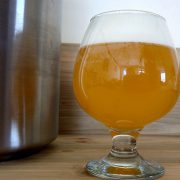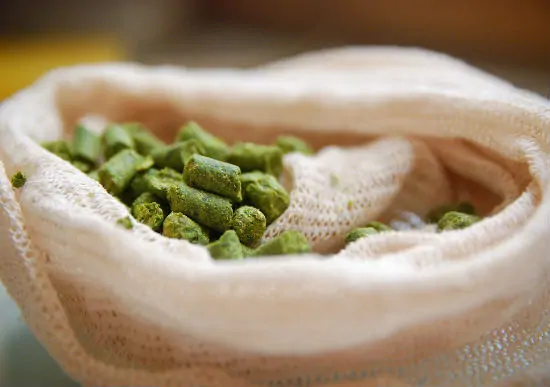Hazy IPA Recipe & A Few Tips To Get Hazy IPA’s Right
Recently, I have been more and more intrigued by the techniques around brewing hazy and often downright murky New England IPAs. People can’t seem to get enough of them and it would seem people often associate the murk levels in these hazy IPAs with mouth-filling juicy hop character.
I have to say I am a big fan of hazy IPAs and find the whole wave of enthusiasm about the style really exciting. I have brewed a few interpretations myself and done a bit tinkering and found the hoppiness isn’t directly correlated with murkiness, although it does have some effect. I have even seen some brewers are deliberately increasing the haze with methods that aren’t so traditional (more on that in a bit).
Table of Contents
Key Variables for Brewing A Hazy IPA
From my experience brewing, these hazy NEIPAs uses a mix of both technique, ingredients and basic adjustments to things like water. The most important things to get right in this style of beer are:
- Huge, juicy, tropical and fruity hop aroma.
- Low bitterness.
- Full and silky mouthfeel.
The key to achieving a Hazy IPA that encapsulates these traits isn’t necessarily about making a murky beer but the haziness is a byproduct.
Hazy IPA Techniques
A few subtle changes in the way you brew an IPA can have dramatic differences in the finished beer, these changes are what keeps the beer hazy and introduces the luscious juiciness of the hop character.
Timing The Dry Hop
It goes without saying that you are going to want to have a heavy hand with the dry hops that go into the fermenter. It is also important to think about when you are adding the dry hop.
Conventionally, you would always what for the primary fermentation to subside before adding dry hops. Brewing NEIPA’s, however, you will want to add your dry hops during active fermentation. I find about 1 – 2 days after pitching yeast is a good time to dry hop for a Hazy IPA.
Dry hopping during active fermentation takes advantage of a process called biotransformation. What this means is that the yeast fermenting the beer transform compounds in hop to slightly different compounds. This in part helps to draw out those intensely fruity and juicy aromas and flavours we want.
After this initial dry hop, I like to dry hop again either in the keg or a few days before bottling to really bolster the aroma.
Focus On Aroma Hops Not Bittering
We want to keep the bitterness levels on the low side. This helps to push full, aromatic qualities of the IPA and keep them front and centre. This means adding the vast majority of the hops at the end of the boil.
There may be no 60 minute hop addition at all. I have had success with hopping 30 minutes into a 60 minute boil and also in the last 15 minutes. This allows for large amounts of hops at flameout or at the end of the boil without pushing too much bitterness.
Body Boosting Grains & Adjuncts
The addition of oats, flaked wheat or barley and other high protein grains and adjuncts is common. These types of grains boost the mouthfeel and body of the beer and also provide a silkiness. This is very typical of the style and these types of grains are found in nearly every example of the style.
These grains also contribute to the haze that is one of the key features of the style.
High Chloride Water
The balance between sulphates and chloride in traditional IPAs and Pale Ales favours the sulphates. Brewing water with high sulphates accentuates the hop bitterness and provides a crispness that is required for traditional hoppy beers. Water that is higher in chloride compared to sulphate at around a 2:1 ratio will enhance the roundness of the malt character and provide a sweeter, fuller bodied beer.
In hazy IPAs and NEIPA we want to minimise bitterness as much as possible and focus purely on aroma and mouthfeel. Water high in sulphates enhances bitterness so you will want to think about this when preparing your brewing water.
Absolutely Minimise Oxygen Exposure
I have brewed NEIPA and packaged in both keg and bottle. By far the best results were the hazy IPAs packaged in keg compared to bottling. Hazy IPAs are very prone to oxidisation which introduces off flavours, mutes aroma hops and in this case, causes discolouration in the beer.
In fact, the bottled versions of these beers completely changed after around 3 to 4 weeks. The colour of the beer went from bright yellow to a darker gold colour. I have seen some home brewers turn muddy brown in the bottle. This appears to be down to oxidation in the bottle or rather caused by the bottling process that is very hard to eliminate at a home brew scale.
Kegging the beer on the other hands is a great way to package and eliminate almost all the oxygen that will oxidise the beer. The kegs can be purged with CO2 and very little beer is exposed to the air when you are kegging compared to bottling.
El Dorado, Citra & Mosaic Hazy IPA Recipe
Recipe Details
| Batch Size | Boil Time | IBU | SRM | Est. OG | Est. FG | ABV |
|---|---|---|---|---|---|---|
| 19 L | 60 min | 53.9 IBUs | 10.2 EBC | 1.055 | 1.014 | 5.3 % |
Fermentables
| Name | Amount | % |
|---|---|---|
| Pale Malt (2 Row) UK | 4.24 kg | 80 |
| Oats, Malted | 742 g | 14 |
| Wheat, Torrified | 318 g | 6 |
Hops
| Name | Amount | Time | Use | Form | Alpha % |
|---|---|---|---|---|---|
| Target | 9 g | 45 min | Boil | Leaf | 11 |
| El Dorado | 35 g | 30 min | Aroma | Leaf | 15 |
| Columbus/Tomahawk/Zeus (CTZ) | 25 g | 30 min | Aroma | Leaf | 15.5 |
| El Dorado | 80 g | 3 days | Dry Hop | Pellet | 15 |
| El Dorado 2nd Addition after 1st dry hop | 60 g | 3 days | Dry Hop | Pellet | 15 |
| Citra | 50 g | 3 days | Dry Hop | Pellet | 12 |
| Mosaic (HBC 369) | 25 g | 3 days | Dry Hop | Pellet | 12.3 |
Yeast
| Name | Lab | Attenuation | Temperature |
|---|---|---|---|
| London Ale III (1318) | Wyeast Labs | 73% | 17.78°C - 23.33°C |
Mash
| Step | Temperature | Time |
|---|---|---|
| Mash In | 67°C | 75 min |
Notes
| Dry Hopped: 2 days in during active fermentation. |
Download
| Download this recipe's BeerXML file |








Hey Neil – just came across Home Brew Answers – some interesting stuff here.
Particularly interested in your advice on New England hazy IPA brewing. I’ve been homebrewing for some years with sometimes mixed results – my more recent West Coast hoppy IPA style beers have been my more successful brews, partly because of the water I suspect so now adopted Beersmith to hopefully make things more consistent.
A few days ago I made my first hazy IPA based on the Weldwerks Juicy Bits recipe that’s available online – it’s great that they’ve scaled this to homebrew size and posted online. It looks quite similar to your recipe that I came across since making my brew.
Your comments on water treatment are helpful and also the oxygen exposure – I hadn’t appreciated quite how important that was with this style of beer. Based on your advice this will be the first beer that I haven’t racked to secondary fermentation. I’ll also be extra careful when bottling/kegging.
And how successful have your brews been? I’m guessing you’re familiar with the likes of Verdant who are based down your way – how do your brews stack up against the likes of theirs would you say? We also have Deya here in Cheltenham who are doing similar things.
Anyway – thanks for the info – great website.
-Andre
Hi Andre,
Hazy IPAs and NEIPAs are definitely a hard beer to get right on a home brew scale. I have had some success and would definitely recommend kegging rather than bottling, the chances of oxidising the beer when bottling are too high and because of the adjuncts results in major discolouration. In comparison, kegging has always worked well for me with no oxidation at all.
I am very familiar with Verdant and live just down the road from their brewery, they seemed to have nailed this style and I know they have used Wyeast London Ale III with a lot of success. I used this yeast strain a few months back and it definitely creates those juicy notes you want in the style.
I was in Cheltenham last week funnily enough but didn’t get chance to Deyas tap room. I have had a couple of their cans though and they are very similar to Verdants. I did manage to go to Wild Beers Jessop House bar which was good and their hazy beer, Nebula is worth trying.
Thanks for getting in touch,
Cheers
Neil
Hi Neil,
Great website, intuitive and motivating me to start my first BIAB using, hopefully, the recipe above.
I am a big fan of the hazy IPA’s. DEYA is popular too and served at our local micro pub (The Beerhouse). It sells out so quickly.
I have a question. Is there a replacement ingredient for the wheat in the fermentable list, as my partner is wheat intolerant? Or maybe I make this batch selfishly and brew another recipe for her instead. LOL.
Thanks anyway.
Rich
Thanks, Rich. The wheat is added to the recipe to provide a smooth mouthfeel and body. I wouldn’t want to advise about substitutes if it would make your partner ill but if barley is not a problem then you could try replacing the wheat with flaked barley. Sorry for the late reply hope it is still helpful
A big help thanks. I will brew this recipe using the suggested replacement to wheat.
Last question I am still learning and want to brew a smaller batch of 10 litres. It is the water volumes I’m struggling with and adapting the fermentables and hops. Any help with this?
Glad I could help. hope the brew goes well. I often brew smaller batches too, you can adjust brewing recipes proportionally, I have written about it here – Scaling Home Brew Recipes
Hope this helps,
Cheers
Hi Neil,
I’ve only recently developed an obsession with these hazy IPAs, having ordered a few cans of the Cloudwater IPA and DIPA.
I’m completely new home brewing, bar one Brooklyn Brewery home brew kit (1 gallon output).
I would love to know your advice on where best to start learning about home brew + Hazy and NE IPAs styles. I like the science side of things and ready to get as stuck into that as necessary.
Appreciate any advice you can give here.
Many thanks. Alex
Hi Alex, these NEIPAs are great gateway beers but can be a challenge to brew sometimes.
To learn the fundamentals of brewing with a fair amount of the reasoning and scientific principles at play then How To Brew by John Palmer is the book I’d recommend.
To understand more about Hazy IPAs and NEIPAs then a book by Scott Janish called New IPAs is going to be right up your alley. He also runs a website with a lot of great information about Hazy IPAs at Scottjanish.com
I love this content! thanks for this one.